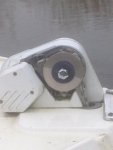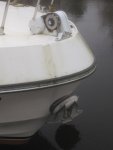Howardnp
New member
I have a Birchwood TS33 Viceroy which I have been spending time on bringing upto date re electronics etc. Currently on the Severn but I intend moving it to South Coast come April....so anchoring isn't such a big issue at the moment.
However, it will be so I've now turned my attention to the windlass, chain etc.
Attached (hopefully) is a photo of the chain and how it goes around the windlass. The anchor itself hangs from the hawsepipe where it exits on the bows.
So the anchor chain comes up the hawsepipe, round the windlass and straight down into the anchor locker.
The question is how do I (safely and without losing fingers etc) get a line attached to the chain to take the load off the windlass when at anchor?
I have a feeling I may be looking at re doing the whole set up and having it go over bow rollers....however, over to your great minds....please!
However, it will be so I've now turned my attention to the windlass, chain etc.
Attached (hopefully) is a photo of the chain and how it goes around the windlass. The anchor itself hangs from the hawsepipe where it exits on the bows.
So the anchor chain comes up the hawsepipe, round the windlass and straight down into the anchor locker.
The question is how do I (safely and without losing fingers etc) get a line attached to the chain to take the load off the windlass when at anchor?
I have a feeling I may be looking at re doing the whole set up and having it go over bow rollers....however, over to your great minds....please!


